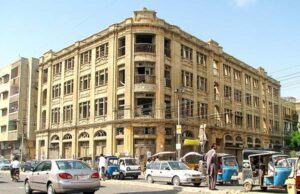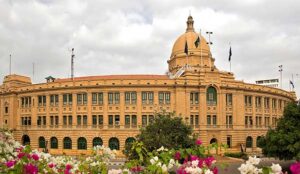For over two decades, the Sindh Cultural Heritage Preservation Act (SCHPA), 1994 — a key legislation for heritage protection within the province of Sindh — has provided a legal base for the protection of heritage. An underlying objective of these heritage enlistments was to enact a cooperative arrangement between the government and property owners, facilitating their scientific management and appropriate conservation. Evidence, however, shows that in spite of a well-developed heritage inventory, the outcome of the listing process has not achieved the desired results. An in-depth analysis of Karachi’s notified heritage properties leads to an understanding of issues behind the disappointing results of the heritage protection law.
In Karachi, the first round of heritage enlistments was carried out in 1995-97; it covered around 600 properties initially, but it has expanded over the years (2011-18) to include hundreds more historic structures officially identified as “protected heritage.” Incorporated within the list are not only landmark monuments, but also private properties owned by individuals or assorted trusts. The ‘criteria for listing’ included architectural, historical and environmental merits, along with locational importance and group values derived from the urban context.

A majority of the heritage property owners resented this process because of the common misconception that they would not be able to make any changes to their properties or sell them. Also their existed a keenness to opt for demolition and redevelopment among them. Additionally some of them felt that since their property had been enlisted, its upkeep and maintenance was now the responsibility of the government. The absence of any initiatives to create awareness about the existing law and its jurisdiction, or a defined channel to provide guidance to heritage owners, further exacerbates the situation. Moreover, prolonged delays in taking decisions on applications received for restoration and development projects, further frustrates the well-meaning property owners as they suffer financial losses. These shortcomings in the system leave owners, occupants, tenants and other stakeholders of heritage properties at a disadvantage. Hence, illegal demolitions, unauthorised constructions, defacing alterations, obscuring hoardings and signage, etc. on such sites remain a norm, despite the penalties for such violations and also because the authorities do not ensure their strict implementation.
Issues of Heritage Property Stakeholders
At an individual property level, a complex mix of issues require attention, including the authentication and validation of ownership deeds, occupancy rights, physical upkeep and maintenance. Furthermore, multiple ownership due to division of inheritance affects properties through incoherent alterations on different subdivisions. Similarly, the properties occupied on a goodwill (pugree) basis suffer from lack of maintenance, as the generated revenue is insufficient for return investments on the longevity and stability of structures. Moreover, since the users do not have complete ownership-rights, they lack interest in spending on their regular upkeep and periodic maintenance.
The common issues recurring in a majority of the listed heritage properties can broadly be classified into five categories:
Usage and Space Utilisation
Originally planned for mixed land use, historic areas commonly had commercial activities at the ground level and residential apartments on the upper floors. Even institutional activities took place within, keeping the convenience of the users in mind. Beyond the clearly defined commercial zones, other parts of the buildings were used for residential purposes. These original, well-balanced usage patterns have changed in many areas due to excessive commercialisation, and now one witnesses extensive infiltration of warehouses on the upper floors. Weak administrative control on land-use changes has severely disturbed the original character of such historic areas.

Abandonment of a building, leading to its collapse, appears an intentional strategy for its inclusion in the Sindh Building Control Authority (SBCA)’s ‘Dangerous Buildings’ list, which opens up a way for possible demolition and new construction, when de-listing appeals are not approved. Lending support to those with a growing desire to demolish and build a new structure there is the Sindh High Density Development Board Act 2010, which allows high rise constructions even within the historic core of the city.
Ownership and Occupancy
In historic areas, the occupancy terms are predominantly on a goodwill (pugree) basis, adversely affecting the property. Many properties have disputed tenancy status, awaiting long-pending settlement of their court cases. These ills of the system impact the physical state of conservation, leading to the present dilapidated state of buildings. Efforts need to be made to either eradicate or officially abolish the prevailing goodwill system of tenancy, and switch over to the standard rental agreements by introducing legislative reforms that protect the interests of both parties. The prevailing system needs to be closely studied to identify the existing issues, and amended to seek appropriate solutions.
Maintenance and Repairs
Ad-hoc repairs, without seeking a prior No-Objection Certificate (NOC) from the concerned authorities, often result in defacing or damaging the original character of the listed properties. In some cases, it also results in incidents of partial collapse due to extensively increased dead loads as well as removal of structural walls. Common alterations broadly fall into three categories;
– haphazard additions or removals, including addition of extra floor/s or room/s above or adjacent to the existing structure; additional new blocks on open spaces of the plot; demolition of some portions of the original structure; addition of toilets or other service spaces, etc.
– changes in the original materials, such as replacement of terracotta roof tiles with metal sheets; replacement of original flooring with new material; cladding of external or internal walls; replacement of wooden door/window shutters with aluminium frames and large glazings, etc.
– change in the original internal layout; this includes subdivision of internal spaces; removal of original walls; addition of partition walls; closing of door/window openings; covering of courtyard with roof slab; addition of new staircases, etc.
In properties having multiple ownerships or occupants, the maintenance and repairs are also not consistent, reflecting on the lack of regulatory control. Strict measures, along with proper guidelines or principles are required, to ensure that the initiatives of individuals remain in consonance with the overall urban environment.
Delisting and Demolitions
Seeking demolition is a popularly sought-after line of action by the heritage property owners. The usual approach adopted is to first apply for delisting, and alongside try to get the property notified as ‘dangerous’ by the SBCA. Cases have been noted where delisting appeals were clearly rejected. However, inclusion of the property in the ‘dangerous buildings list’ led to their demolition and subsequent new construction. Lapses in regulatory systems have led to a substantial number of listed properties having undergone partial or complete demolitions, with or without acquiring required approvals or authorised permissions.
Plot Subdivisions
Besides getting a property de-listed or declared “dangerous,” another approach is that of plot sub-divisions, which creates a provision for retaining only a small portion of the heritage property — mostly its street-facing frontage. Approval for new construction is obtained for the newly allotted plot number of the subdivided portion/s. The authority responsible for such plot sub-divisions is the Revenue Department’s Land Section, which takes decisions independently, without consulting either the Culture Department or the SBCA. It is essential that such decisions go through proper checks to ensure that listed heritage properties are not allowed damaging fragmentation.
Historic areas largely suffer from an overall environmental degradation and declining urban fabric. To revive the charisma of such places, action is needed at two distinct levels: the environmental and the individual property levels.
Two possible means of achieving tangible progress in this regard is firstly, by attempting street reorganisation through community support, and secondly facilitating restorations through technical and financial support. For any real change, things need to be taken beyond mere listing notifications — invest in directional strategies that facilitate heritage owners in gaining some benefits from the enlistment process. Grants, awards, rebates, loans for repairs and restorations, technical support/ guidance for economically viable usages, etc. can be possible incentives to encourage willing participation from heritage property owners for conservation.
The constraints imposed on heritage owners or other properties in conservation areas, such as ‘denial of full development value of site’ or restricted freedom for implementation of any desired changes or alterations, gives rise to financial loss or economic burden on the owners. To compensate for these losses programmes offering a diverse array of financial aid should be offered through various government initiatives. Some proposed directives for the Department of Culture, Sindh, in collaboration with other concerned departments/ organisations responsible for heritage management, include three principal categories;: subsidies (grants/ aids), loans (low-interest or interest-free) and tax relief (VAT/ property tax).
Another interesting concept is that of Transfer of Development Rights (TDR) allowing owners to sell their unutilised floor area of allowed ratio (FAR) to a developer in another area. Karachi Building and Town Planning Regulations – 2002 (KBTPR 2002) incorporated the concept of ‘transferable development rights’ through section 15-3.2. This clause was, however, removed through amendments in 2005 and 2008. Governmental patronage through ‘revolving funds’ and ‘endowment funds’ should also be made available, encouraging agencies or institutions to undertake rehabilitation projects, restoring properties for economically viable purposes. Another useful concept is that of Façade Easement where part of the property (such as the façade) is taken under public ownership through an ‘easement agreement’ signed by the owner, allowing maintenance and repairs of their property’s façade through sponsorships or easement donations. This particularly works well in areas with officially recognised continuous heritage streetscapes. The Culture Department should develop a working module for such easement agreements and approach all heritage property owners to sign these agreements. Possible donors/ sponsors willing to contributing towards maintenance of façades can be sought through public-private partnerships.
There is also an urgent need to ensure transparency and smooth processing of NOCs for restoration, renovation or rehabilitation of projects. The indefinite delays by the Culture Department in processing such applications are a primary cause of frustration among heritage-property owners. This issue can be addressed by the relevant government departments through certain corrective measures such as;
– developing an ‘online portal’ for submission of applications and any other objections or complaints regarding listed heritage, supported by a ‘public service counter,’ where complaints of the historic property-owners are received, and dealt with immediately. The process of receiving the applications should be made online, to ensure timely processing of specific files.
– A strong liaison between SBCA and the Culture Department should be established to facilitate the process of NOCs for the proposed changes — either additions or alterations in the original fabric.
– Establishment of field offices in all historic quarters/ cities to ensure effective monitoring of heritage properties; providing heritage-owners free advice and guidance on matters related to the technical aspects of management and maintenance. Community volunteers can also be engaged in this process and given basic training to deal with the primary issues at the community level.
Heritage conservation can gain momentum only if appropriately rationalised vis-a-vis with economic sustenance, reaping direct benefits for associated communities. Unless the planning and development processes do not integrate the mandate of heritage preservation within its policies and strategies for administrative systems, it is unlikely that any positive change will ever take place. In an attempt to restore Karachi to its ‘former glory,’ the Sindh Government on the directives of the Court, initiated a brainstorming session with professionals and planning experts in February 2019, where the issue of the city’s heritage was discussed at length. Among many other recommendations on various aspects of urban planning, some radical recommendations were put forward for consideration. These included the proposal to establish a ‘Karachi Heritage District Authority’ and demarcation of Heritage District boundaries, within which the regulations would strictly remain sensitive to the cause of heritage preservation, disallowing application of the High-Density Act 2010 within its limits. Unless such drastic measures are taken to relieve the city’s historic core from the pressures of commercialisation and uncontrolled development leading to extensively increased high densities, it is unlikely that the cause of heritage preservation will make any meaningful progress. Developments for the Walled City of Lahore on similar lines, have started to show signs of success, and can bring similar results in Karachi as well.
Note: This article is compiled from excerpts of a chapter titled “Evolution and Repercussions of Heritage Designation Process in Sindh: Lessons from Karachi and Shikarpur,” from a book Historic Urban Landscapes in Asia Pacific ed. Silva.

The writer is the Chairperson of the Department of Architecture and Planning, N.E.D. University of Engineering and Technology, Karachi.

